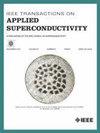HTS for Future Circular Collider Beamscreen: New Moderate High-Pressure Reaction for the Synthesis of Tl-1223
IF 1.8
3区 物理与天体物理
Q3 ENGINEERING, ELECTRICAL & ELECTRONIC
引用次数: 0
Abstract
This study focuses on the synthesis and characterization of the Tl0.7Bi0.2Pb0.2Sr1.6Ba0.4Ca1.9Cu3O9+x (Tl-1223) superconducting phase, with particular emphasis on constructing a detailed phase diagram that maps its formation across varying temperatures and oxygen pressures. By optimizing these parameters, we were able to determine the precise conditions for obtaining a high-purity Tl-1223 phase. X-ray diffraction (XRD) and scanning electron microscopy (SEM) were used to examine the crystalline structure and morphology, while magnetic properties were investigated using SQUID magnetometry. The phase diagram provides critical insights into the stability of Tl-1223, guiding future synthesis efforts. Our magnetic measurements confirmed superconducting behavior with a critical temperature of approximately 120 K, validating the optimized synthesis process. Though primarily focused on phase formation, this research also opens up the potential for applying Tl-1223 in the Future Circular Collider (FCC) as a beam screen coating material. The superconducting properties of Tl-1223 make it a promising candidate for overcoming the limitations of traditional materials under FCC operational conditions. Future work will explore the preparation of Tl-1223 films for this application.未来圆形对撞机光束屏的高温超导:合成Tl-1223的新中高压反应
本研究的重点是Tl0.7Bi0.2Pb0.2Sr1.6Ba0.4Ca1.9Cu3O9+x (Tl-1223)超导相的合成和表征,特别强调构建了详细的相图,绘制了其在不同温度和氧压下的形成图。通过优化这些参数,我们能够确定获得高纯度Tl-1223相的精确条件。采用x射线衍射(XRD)和扫描电镜(SEM)对晶体结构和形貌进行了表征,并用SQUID磁强计对其磁性能进行了表征。相图提供了对Tl-1223稳定性的重要见解,指导未来的合成工作。我们的磁性测量证实了超导行为,临界温度约为120 K,验证了优化的合成工艺。虽然主要集中在相形成上,但这项研究也为Tl-1223在未来圆形对撞机(FCC)中作为光束屏涂层材料的应用开辟了潜力。Tl-1223的超导特性使其有望在FCC操作条件下克服传统材料的局限性。未来的工作将探索为这一应用制备Tl-1223薄膜。
本文章由计算机程序翻译,如有差异,请以英文原文为准。
求助全文
约1分钟内获得全文
求助全文
来源期刊

IEEE Transactions on Applied Superconductivity
工程技术-工程:电子与电气
CiteScore
3.50
自引率
33.30%
发文量
650
审稿时长
2.3 months
期刊介绍:
IEEE Transactions on Applied Superconductivity (TAS) contains articles on the applications of superconductivity and other relevant technology. Electronic applications include analog and digital circuits employing thin films and active devices such as Josephson junctions. Large scale applications include magnets for power applications such as motors and generators, for magnetic resonance, for accelerators, and cable applications such as power transmission.
 求助内容:
求助内容: 应助结果提醒方式:
应助结果提醒方式:


